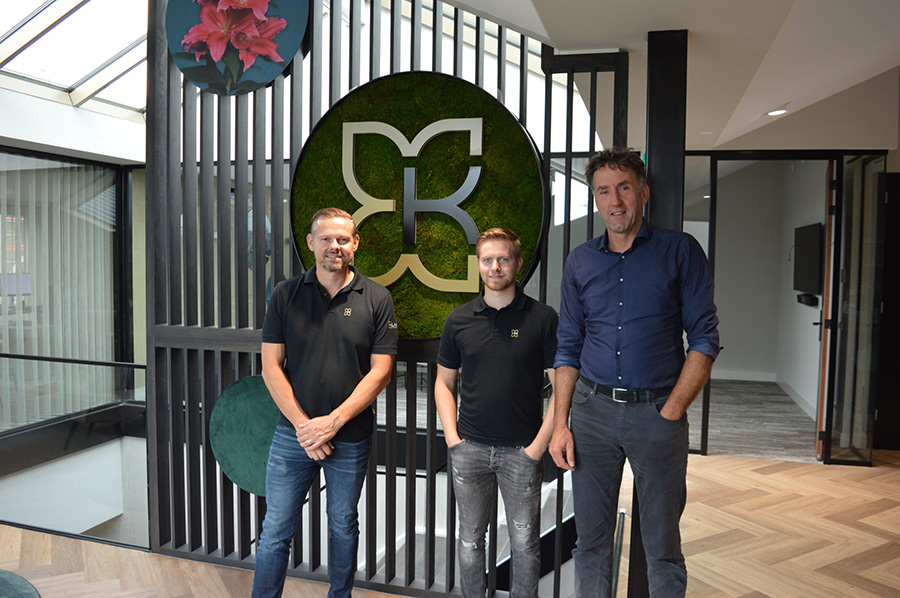- English

The spring water at Klaver Flowers’ farm in Ethiopia is abundant, but high in sodium and bicarbonate. To get the EC down, the grower therefore uses osmosis technology, which is effective but also has a price tag…
When Hortus Supplies International (HSI BV) proposed to start a practical trial with an AQUA4D® water improvement system in collaboration with Aqua4D-Lescrauwaet BV, owner Gert-Jan Klaver initially reacted somewhat skeptically, but also curiously. “If it doesn’t help then it doesn’t hurt. We had seen good results elsewhere in roses and vegetables, so I was keen to try it.”
10% water saving
Immediate results after starting an initial trial in part of the crop were substantial water savings. This, it later turned out, could vary greatly according to the changing weather conditions, but ended up at around 10% on average. That also meant a 10% saving on fertilizer use, and as the farm has grown considerably in recent years – now growing mainly gypsum and limonium on some 50 ha – that is a nice bonus.
Immediate results after starting an initial trial in part of the crop were substantial water savings. This, it later turned out, could vary greatly according to the changing weather conditions, but ended up at around 10% on average. That also meant a 10% saving on fertilizer use, and as the farm has grown considerably in recent years – now growing mainly gypsum and limonium on some 50 ha – that is a nice bonus.
In addition, soil moisture, which is important for good root system formation, is significantly more even. ‘We grow the flowers on beds,’ Gert-Jan says over a cup of coffee in the brand-new office at the farm in Heerhugowaard, ‘and a good distribution of water is very important here. Previously, the water sank down in a cone shape, the horizontal distribution left much to be desired. Moreover, with a lot of side radiation, we often saw the sides of the beds drying out. We also see now that, especially with the gypsum, the roots are less salt-sensitive.”
Resonating
Aqua4D technology improves the molecular structure of the irrigation water using a resonance technique developed in Switzerland based on electromagnetic signals. The water structure refines, fluidity or surface tension improves, the effect of bicarbonate is reduced, the water absorbs nutrients better and, together with the nutrients, is easily absorbed by plants.
It is therefore not surprising – or indeed, it is to be expected – that the plant above ground also benefits. “We would like to achieve above-average quality, the stems are preferably all 80 cm and weigh at least 30-35 grams. To achieve that, everything has to be right and since we started with AQUA4D® we do indeed see slightly longer and somewhat heavier stems. In addition, the soil structure is looser and we see a bit less sunburn on the leaves.”
So Ethiopia, so Heerhugowaard
More or less synchronous with the field tests in Ethiopia, an AQUA4D® rental trial was also started in the greenhouses in Heerhugowaard. This is indeed a completely different crop (lilies, in crates, under glass) and under completely different climatic weather conditions, but when it comes to issues such as savings and quality improvement, optimization is also on the cards here.
The initial findings proved almost identical: a 10% saving on water, a more even moisture distribution, better crop flow and, especially in winter, the crop dries considerably faster. Moreover, Gert-Jan and cultivation manager Jesse Bergsma note that the pipes have become cleaner: there is less deposit in the pipes and filters also need to be replaced less often.
Plug & play
After a thorough preliminary process, the Aqua4D system is now ‘plug & play.’ It is installed in the main pipeline and then not to be looked after for years. On the farm, after an initial unit used to irrigate 3 ha, three units have now been installed to supply the entire farm of about 14 ha of production with irrigation water. ‘This number is not primarily correlated to the amount of water flowing through the Aqua4D treatment tube, but more of the entire water column itself because it also has its effect in stagnant water,’ explains Raymond Lescrauwaet of the Hilversum-based Aqua4D-Lescrauwaet, which has now been importing for 12 years.
“The art of the technology is to find the precise resonant frequencies of the water, while counteracting any outside interference as much as possible. This is why we take all kinds of environmental measurements beforehand at various points in the greenhouse and especially where water or power lines run or, as in this case, there is a high-voltage pylon nearby. If you have all that insight, then basically all the water that is in that particular (greenhouse) circuit is treated to the maximum.”
Looking ahead into the future and being able to accurately pinpoint the differences between AQUA4D® treated and untreated (reference) boxes often also says something about the expertise and commitment of the grower in question, Raymond adds. ‘At Klaver Flowers, in addition to a progressive and approachable management team, the situation is excellent with motivated cultivation managers like (former) Rob, Danny and Jesse.’
Looking ahead
The men are quite pleased with the findings: Klaver Flowers with the investment/savings and the heavier quality of the flowers and Aqua4D-Lescrauwaet with a splendid reference in both Heerhugowaard and faraway Ethiopia, with thanks to Jack van Winden of export-partner HSI BV.
‘It’s not magic,’ concludes Gert-Jan, ‘we measure consistently and observe clear improvements. We hope to further expand our farm in Ethiopia in the near future and with today’s knowledge that will definitely include an AQUA4D® system.”